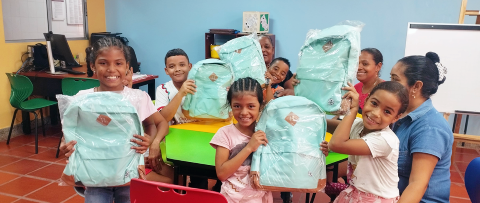
Children in Colombia receive school supplies from a workplace giving partner.

Alexandra Geneser
SENIOR MANAGER, GLOBAL PARTNERSHIPS
Alexandra Geneser has over 15 years of experience in building global partnerships across private, public and nonprofit sectors, focusing on children and youth services, environmental advocacy and housing equity. She has worked with organizations like Amazon, Microsoft, Coca-Cola and the World Bank Group. She holds a master’s in nonprofit leadership from the University of Pennsylvania and a bachelor’s in international development, and started her career with the Peace Corps. Alexandra brings a global perspective and a deep commitment to advancing social impact through cross-sector collaboration.
The Gates Foundation, Apple and Merck are among over 700 workplace giving partners of Children International.
This Microsoft employee’s experience exemplifies the profound impact of workplace giving. What began in the United States as a way for employees to support local causes has grown into a global movement, evolving into a powerful force for positive change, helping communities around the world achieve their dreams through collective support.
As a member of Children International’s Global Partnerships team, part of my role is managing our workplace giving programs — a responsibility I truly love. Our team is fortunate to collaborate with thousands of passionate donors, volunteers, institutional partners, global staff and the children, youth and families in our programs.

Alexandra Geneser takes a selfie with Microsoft employees at a workplace giving event during a global finance conference last year.
Workplace giving has a rich history. It began in the U.S. in the 1920s with Community Chests, which later evolved into United Way campaigns, enabling employees to pool their donations for local causes. During World War II, the introduction of payroll deduction systems simplified giving. By the 1950s, General Electric launched the first known corporate matching-gift program — a concept that gained momentum throughout the 1980s and 1990s as companies increasingly embraced employee-driven social impact. In the early 2000s, Microsoft helped popularize Dollars for Doers programs by encouraging volunteerism and matching volunteer hours with financial contributions to nonprofits.
Workplace giving is not only essential to Children International programming — its impact transcends borders, connecting people through generosity and shared purpose.
Microsoft pioneered the month-long giving and volunteerism model, inspiring other companies to adopt similar initiatives that now raise millions annually. Over the past two decades, these programs — grouped under the broader umbrella of workplace giving — have continued to surge. Third-party platforms like Benevity and Global Impact have further streamlined the process, removed administrative hurdles and made giving easier and more impactful than ever.
As this space continues to evolve, Children International is not only keeping pace, but leading the charge — participating in global workplace giving campaigns, leveraging tools like Benevity to connect with supporters, and offering innovative, one-of-a-kind volunteer experiences. These experiences blend the magic of traditional hands-on activities with new opportunities that use cutting-edge technologies like artificial intelligence (AI). With a forward-thinking approach and a deep commitment to impact, Children International is deeply grateful for the generosity and sense of community that workplace giving fosters.

Workplace giving volunteers can use their own creativity or AI to create bookmarks to improve children’s literacy as one of the ways to participate in volunteering opportunities with Children International.
Today, over $5 billion is donated annually through workplace giving in the U.S. Two-thirds of Fortune 500 companies offer matching gift programs, while public institutions, such as U.S. government agencies and the World Bank Group, facilitate employee giving through payroll contributions, supporting more than 20,000 nonprofits worldwide. Despite this generosity, an estimated $4 to $7 billion in matching gift funds go unclaimed each year, largely due to a lack of awareness that employee donations and volunteer hours can be matched. At Children International, we are committed to making sure our supporters know these resources exist and are intentionally growing workplace giving by welcoming new organizations and their employees from private and public sectors alike.
This support is not only essential to our programs — its impact transcends borders, connecting people through generosity and shared purpose. Volunteerism — an integral part of these efforts — creates moments of joy and a bond that resonates long after an activity ends.
Volunteering with Children International can include:
These experiences are enhanced using technology to improve both the experience and the outcomes of each project. They happen in real time through live, facilitated sessions with our staff or through flexible virtual formats that allow anyone to participate from anywhere in the world.
At the center of these programs are children and youth, who not only benefit from the contributions, but they also help shape the initiatives that support them. Generous supporters and partners complete the circle and bring it all to life. Being part of this process — building connections, co-creating, learning from others and witnessing how these collective efforts lead to real, lasting change — is what I love most about my job.
Enjoyed this piece? Discover how Children International benefits from workplace giving by reading two Global Impact white papers in which we were recently featured.

Volunteers from around the world celebrate Children International Into Employment graduates by sending congratulatory letters.
We invite you to learn how you can participate in workplace giving with us.
Comments
You must be logged in to comment. If you have an account, click here to log in.